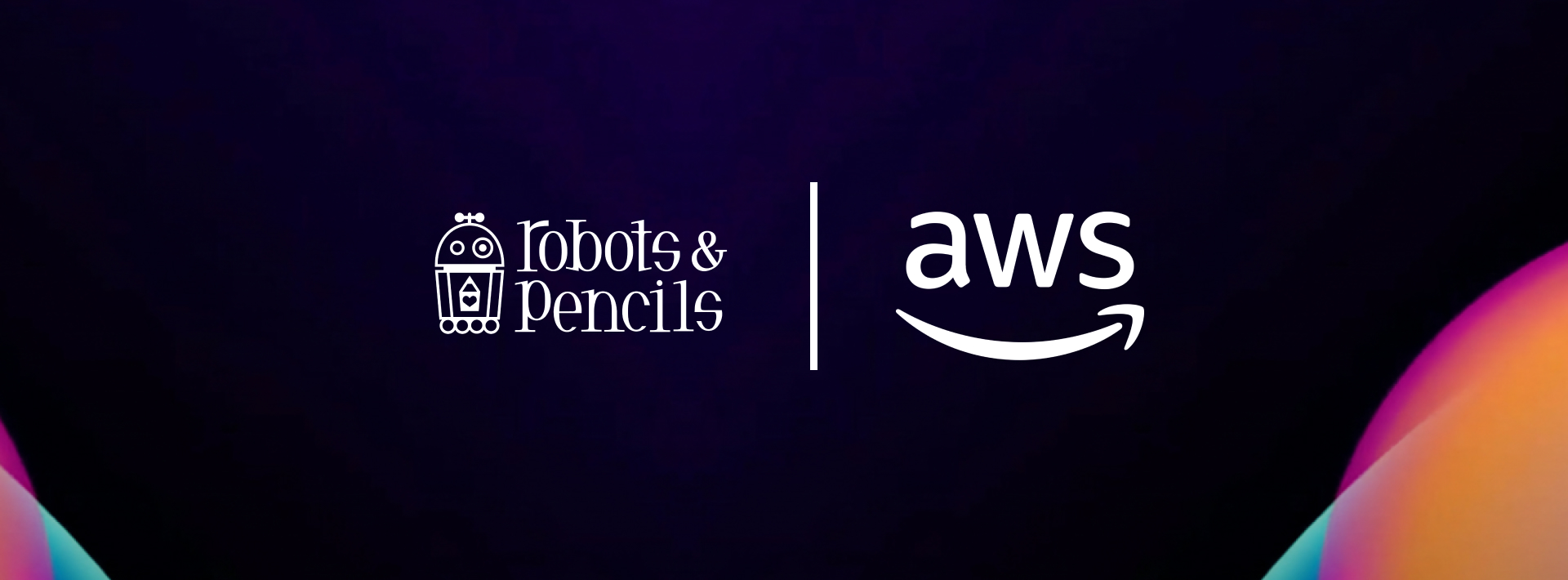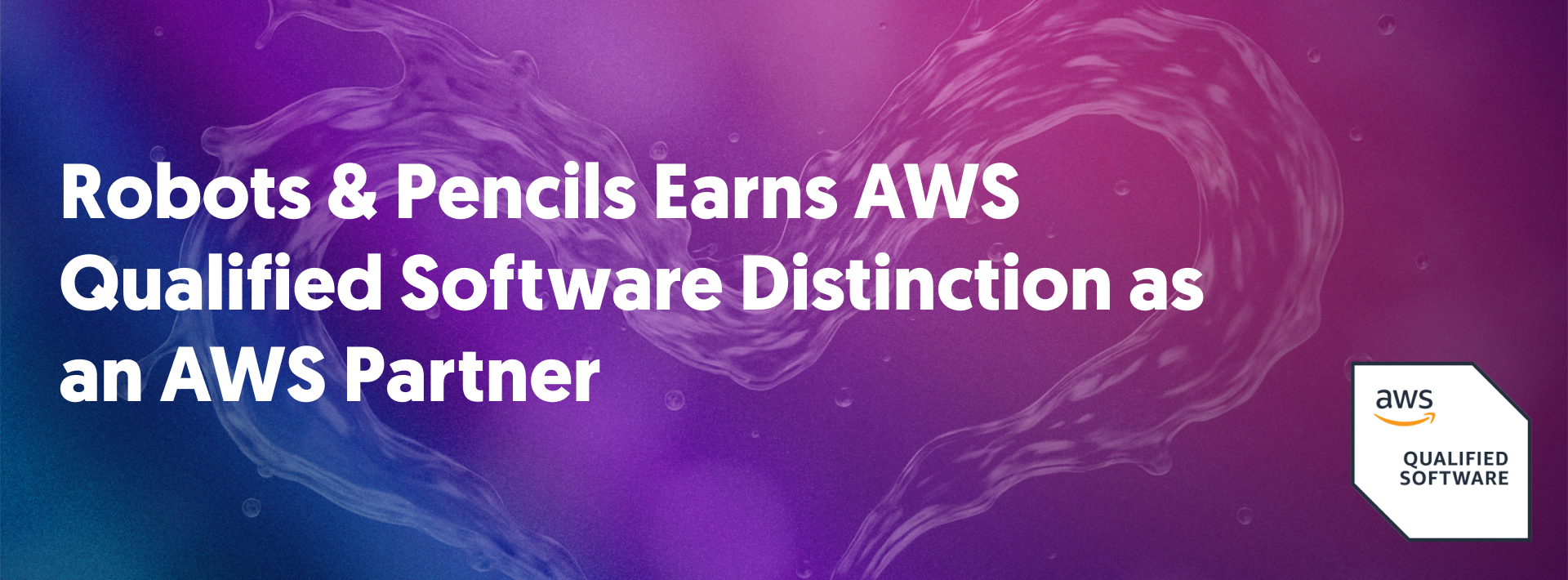Today, Robots & Pencils joins AWS as a launch partner in the AWS Pattern Partners program, an invite-only initiative that works with a select cohort of consulting partners to define how enterprises adopt next generation AI and emerging technologies on AWS.
As a Pattern Partner, Robots & Pencils brings proven success with emerging technologies on AWS, including AI/ML, Generative/Agentic AI, Robotics, Space Technology, and Quantum. The program focuses on accelerating enterprise adoption through repeatable, scalable patterns that encode tested ways to solve specific business problems, with architecture, controls, and delivery practices that have already been validated with customers.
For customers, selection of Robots & Pencils into this program signals that AWS has reviewed and endorsed both the outcomes and the operating model behind the work delivered in these domains. Enterprises that face pressure to modernize critical processes, adopt AI safely, and respond to new regulatory and security requirements gain access to patterns that have already delivered measurable results.
Pattern Partners also sets a clear horizon view for emerging technology. In the near term, it concentrates on AI/ML, Generative & Agentic AI patterns, including sub domains such as Process to Agent (P2A), Agent to Agent (A2A), Responsible AI, and RegAI. Over the midterm, the program extends these capabilities into connected environments that use Robotics, IoT, and Edge and Space Technology on AWS. For the long term, it explores Quantum and next generation enterprise innovations, aligning new capabilities with existing AWS investments in data, AI, and security as they mature into reliable patterns.
Our Pattern: Enterprise Document Intelligence Platform
At the heart of the participation of Robots & Pencils in Pattern Partners is a flagship pattern that the company is co-developing and scaling with AWS.
The Customer Problem
Organizations in Energy, Manufacturing, and Health & Wellness face a common set of challenges. Data and workflows sit in disconnected systems, which slows AI adoption and creates duplicated effort. Teams find it difficult to govern AI models and agents at enterprise scale, especially when regulations and internal standards move quickly. Talent and process gaps make it hard to adopt new technology in a way that satisfies risk, compliance, and operational leaders.
Our Joint Approach with AWS
Together with AWS, Robots & Pencils has designed the Enterprise Document Intelligence Platform. This pattern combines an architecture built natively on AWS using Amazon Bedrock, Amazon SageMaker, and Amazon Bedrock AgentCore, an operating model with clear roles, runbooks and guardrails for IT, data, security and business teams, and accelerators such as pre-built integrations, automations, policies, templates, dashboards and agents. This pattern is being refined through a time boxed incubation with a set of lighthouse customers. As it matures, it is packaged as a Pattern Package so that more joint customers can adopt it rapidly with consistent results.
Early Results
Early adopters are already reporting tangible outcomes from the Robots & Pencils’ Enterprise Document Intelligence Platform. With 2 million interactions across 100,000+ users, customers reported a 90% satisfaction score and 40% improved confidence in responses from the pattern.
As these results are validated across additional lighthouse customers, the Pattern Package becomes available to AWS field teams globally. This enables customers in new regions and sectors to benefit from the same proven approach without restarting design from the beginning.
How the Pattern Partners Program Works with Customers
When a customer engages Robots & Pencils through the Pattern Partners program, the engagement starts from a proven blueprint, not from scratch. The Pattern Package already encodes successful implementations, including architectures, guardrails, and playbooks. Customers receive coordinated support from AWS specialists, the AWS Consulting COE Pattern Partner team and experts from Robots & Pencils across consulting, engineering, and product.
The program design supports fast yet responsible experimentation. Customers can move from idea to live pilot while maintaining enterprise grade security, compliance and governance. The pattern also includes a clear path from pilot to scale, so organizations can extend from initial deployments to cross region and multi business unit rollouts with ongoing optimization.
Being part of the AWS Pattern Partners program allows Robots & Pencils to bring emerging AWS capabilities such as Generative AI and Agentic applications to customers earlier. Guardrails and controls stay clear and well defined. The company can turn its strongest customer successes into repeatable assets that benefit a wider set of organizations. Collaboration with AWS field teams, solution architects and service teams keeps the pattern aligned with the latest platform innovation. Robots & Pencils also contributes back to the broader AWS partner ecosystem by sharing learnings and raising the standard for how emerging technology is adopted. For customers, this approach reduces risk, increases predictability, and accelerates business impact from AWS investments.
Partner Perspective
“Joining AWS Pattern Partners is a strategic milestone for Robots & Pencils,” said Jeff Kirk, Executive Vice President of Applied AI, Robots & Pencils. “With our Enterprise Document Intelligence Platform, we turn our strongest customer wins into a clear, repeatable path to reduce onboarding time for customers in need of intelligent search, and increased confidence in the accuracy of the results, so customers can move from pilots to production with greater speed, control and confidence.”
AWS Perspective
“AWS created Pattern Partners to work with a select cohort of builders who can set the standard for how enterprises adopt emerging technology on AWS. Robots & Pencils brings deep expertise in KnowledgeOps, including RAG and compound systems, and a proven pattern in the Enterprise Document Intelligence Platform that is already delivering measurable outcomes for customers,” said Brian Bohan, Managing Director of Consulting COE, AWS. “We look forward to scaling this work together and bringing these benefits to more joint customers across industries.”
Next Steps
Customers interested in these patterns can speak with Robots & Pencils through Robotsandpencils.com/contact to review current challenges and identify which patterns are most relevant.
Those that want to explore Enterprise Document Intelligence Platform in depth or learn how the AWS Pattern Partners program could support their own roadmap can request a focused discovery session. In that conversation, AWS and Robots & Pencils work with stakeholders to map business challenges to the pattern, estimate potential impact, and define a practical path to adoption.
Together, AWS and Robots & Pencils look forward to turning critical business challenges into repeatable, scalable patterns for growth.
The pace of AI change can feel relentless with tools, processes, and practices evolving almost weekly. We help organizations navigate this landscape with clarity, balancing experimentation with governance, and turning AI’s potential into practical, measurable outcomes. If you’re looking to explore how AI can work inside your organization—not just in theory, but in practice—we’d love to be a partner in that journey. Request an AI briefing.
Key Takeaways
- Robots & Pencils has been selected as a launch partner in the invite-only AWS Pattern Partners program, recognizing leadership in next generation AI and emerging technologies.
- The joint Enterprise Document Intelligence Platform provides a validated, repeatable pattern that helps enterprises adopt Generative and Agentic AI with confidence.
- The pattern incorporates AWS native services such as Amazon Bedrock, Amazon SageMaker, and Amazon Bedrock AgentCore, along with an operating model, runbooks, guardrails, and pre-built accelerators.
- Early lighthouse customers report strong outcomes including high satisfaction, increased confidence in accuracy, and millions of successful interactions.
- The program gives organizations a faster, clearer path from idea to pilot to full scale rollout, supported by coordinated teams across AWS and Robots & Pencils.
- Enterprises gain access to patterns that reduce risk, increase predictability, and produce measurable business impact from AWS investments.
FAQs
What is the AWS Pattern Partners program?
It is an invite-only AWS initiative that works with a select group of consulting partners to define how enterprises adopt next generation AI and emerging technologies through validated, repeatable patterns.
Why was Robots & Pencils selected as a Pattern Partner?
AWS recognized the company’s proven outcomes across AI and emerging technologies, as well as its track record delivering measurable results with scalable architectures and operating models.
What is the Enterprise Document Intelligence Platform?
It is a jointly designed pattern that uses AWS native services and accelerators to help organizations unify data, streamline governance, and deploy Generative and Agentic AI across complex environments.
Which AWS technologies power the pattern?
Key services include Amazon Bedrock, Amazon SageMaker, and Amazon Bedrock AgentCore, along with AWS controls, security practices, and operational frameworks.
Who benefits most from this pattern?
Enterprises in sectors like Energy, Manufacturing, and Health and Wellness that face challenges with disconnected data, evolving regulations, and the need for responsible AI adoption at scale.
What results have early adopters seen?
Customers reported 2 million interactions across more than 100,000 users, a 90 percent satisfaction score, and a 40 percent improvement in confidence in response accuracy.
How does the program support faster innovation?
Organizations begin with a proven blueprint rather than a blank page. This accelerates pilots while maintaining enterprise grade governance and provides a clear pathway to large scale deployment.
How do customers engage?
Teams can connect through Robotsandpencils.com/contact to discuss current challenges or request a focused discovery session to understand fit, impact potential, and next steps.
What does this mean for long term innovation?
The program continually extends into new domains, guiding enterprises through emerging capabilities such as Robotics, IoT, Space Technology, and Quantum as they mature into reliable patterns.













